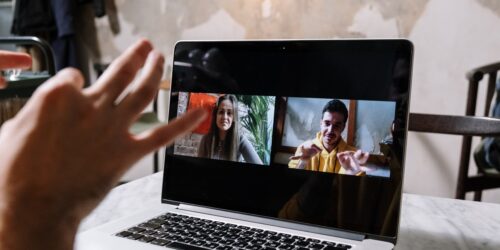Exam Proctoring in Zoom
By Laura Stoutenburg and Joel Beaupré
In considering how to proctor an online synchronous assessment, a range of tools and strategies have been used to help facilitate tests and exams. For example, some have used Zoom to assist with certain aspects of online synchronous proctoring, including the need to verify students’ identities prior to or during a test. However, this practice can be difficult for faculty and students and may be better managed using some of the suggestions outlined here.
Photo Class List Check
Early in the semester, remind students to upload their official ONE Card photo so that faculty can verify their appearance using the Class List > Photo ID feature under the Faculty tab in the Employee Portal. This tool provides a straightforward way to match names with faces, which helps mitigate the need to conduct manual ID checks when facilitating tests.
The college connects with students to ensure they are aware of the uses of the ONE Card and the process to obtain their ONE Card in the following ways:
- Orientation Checklist
- International Student Checklist
- Direct Email to Incoming Students
Still, if faculty notice that some photos aren’t appearing in the system, they can remind students to explore the benefits of getting their card.
Get to Know Student Images
Throughout the semester, faculty can also do their best to normalize the use of video during weekly synchronous class meetings so that they can identify students without requiring IDs at exam time. Although students can always opt out of this or mute their cameras whenever they wish (and some might not have access to webcams), many will accept and value the opportunity to participate in a more visual, interactive format. Faculty can also join small groups or individuals in breakout rooms and ask for video on. Having the photo class list on hand can allow faculty to check off who they are familiar with.
Spot Check ID
Students should be advised they must have ID on hand for all tests and exams. On the day of exams, if faculty still need to verify the identity of some students, those individuals can be asked to arrive on Zoom before the official start of the test so that they can display their photo ID (preferably a ONECard) within a private space such as a breakout room on Zoom. Students can also be pulled into a breakout room for a check should a concern arise.
Remember: a student’s ID is private and confidential; it is not to be displayed or shared in the presence of other students.
Double-Check
If faculty decide to visually proctor test-takers over Zoom, it may be helpful to occasionally check in by asking students or individuals to raise their hand or gesture that they can hear instructions. This confirms their connection, reminds them that faculty are present for support, and discourages tactics such using a virtual video background to imitate presence at the computer. Watch this example of check-ins.
Online Proctoring Tools
Finally, faculty can consider using the more established proctoring service, Respondus Monitor, if their exam is closed-book and more susceptible to being compromised in an online synchronous or asynchronous setting. Respondus has its own secure way of verifying a student’s ID.
Respondus comes with its own set of challenges for both faculty and students, and its reports still require manual oversight and review. Please refer to the Respondus Monitor Guide on student exemptions, notifications, and onboarding for more information.
Background Reading
Eaton, S. (2020). 3 reasons why proctoring an exam on Zoom is a bad idea. Retrieved from Learning, Teaching and Leadership at https://drsaraheaton.wordpress.com/2020/03/31/3-reasons-why-proctoring-an-exam-using-zoom-is-a-bad-idea/.
Harvard University – Department of Government. (2020). Proctoring a closed-book exam in Zoom. Retrieved from https://gov.harvard.edu/proctoring-closed-book-exam-zoom.
Lin, A. (2020). Let slip the dogs of war: The current e-proctoring dilemma. Retrieved from .https://employees.senecacollege.ca/spaces/153/academic-newsletter/home.
Norman, D. (2020). Zoom online exam proctoring demo. Retrieved from https://darcynorman.net/2020/03/23/zoom-online-exam-proctoring-demo/.



